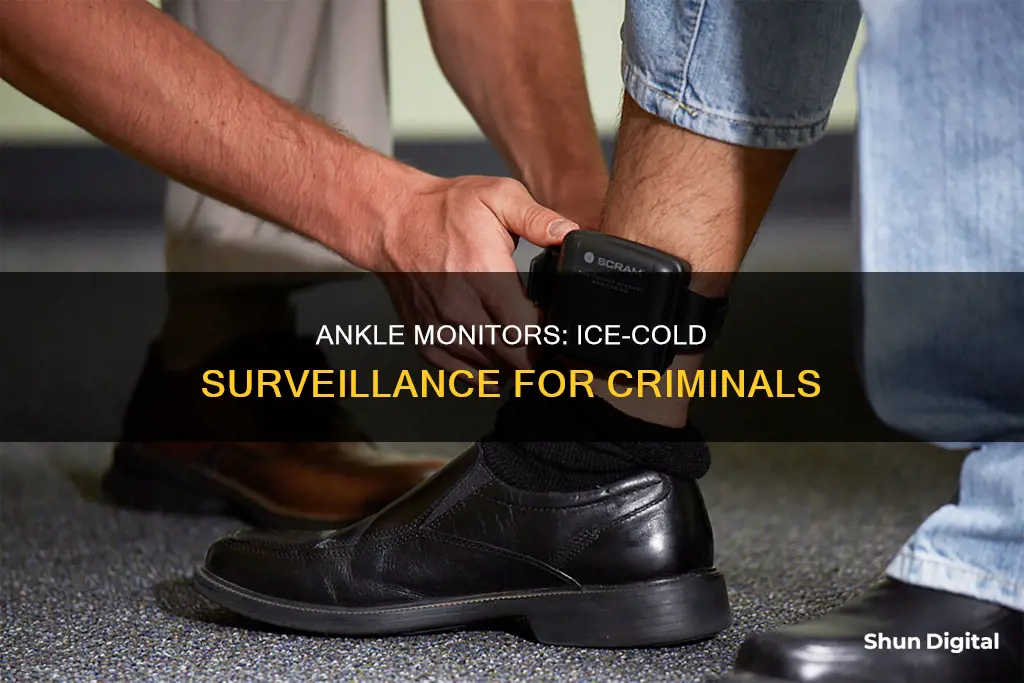
An ICE ankle monitor is an electronic device fitted to the ankles of immigrants in the US, which tracks their location via GPS. The monitor is used as an alternative to detention for immigrants awaiting their court cases to be heard. The monitor has been criticised for causing physical and psychological harm to wearers, including electric shocks, overheating, bruising, and anxiety.
What You'll Learn

The Intensive Supervision Appearance Program (ISAP)
ISAP was launched in 2004 as a "humane" alternative to detention for immigrants awaiting their court dates. The program allows immigrants to live with their families and continue working while their deportation proceedings are pending, as these proceedings tend to be lengthy and often last years.
ISAP utilizes a combination of monitoring methods, including nightly curfews, electronic monitoring devices such as GPS ankle bracelets, voice recognition software for telephone-based reporting, and intensive case management sessions. The specific methods used for each participant are determined on a case-by-case basis, taking into account factors such as criminal history, compliance history, community or family ties, and humanitarian or medical concerns.
The program is run by BI Inc., a private contractor that tracks the whereabouts of immigrants on behalf of US immigration authorities. Participants in the program are required to meet regularly with a case manager and are subject to unscheduled check-ins. While ISAP has allowed some immigrants to be released from immigration detention, there have been reports of issues with the technology used, including painful and malfunctioning ankle monitors, and concerns about the opaque decision-making processes within the program.
As of January 2022, at least 182,607 people were enrolled in ISAP, making it the largest supervision program of any US law enforcement agency. The daily cost per participant is less than $8, compared to the cost of detention, which is around $150 per day.
Secretly Monitoring iPhone Usage: A Step-by-Step Guide
You may want to see also

The physical and psychological toll of ICE ankle monitors
Immigration and Customs Enforcement (ICE) ankle monitors have been described as a "humane" alternative to detention for immigrants awaiting their court dates. However, the monitors have been found to take a significant physical and psychological toll on asylum seekers.
Physical Effects
The ankle monitors are large and bulky, making it difficult for immigrants to walk and move around. They can also cause bruising, overheating, and electric shocks. One woman reported that the monitor burned her skin, causing it to turn red and bleed. Others have reported experiencing cramps, numbness due to impaired circulation, and swelling. In some cases, the electric shocks have been severe enough to send people to the emergency room.
Psychological Effects
The constant surveillance and fear of being watched by the US government take a significant psychological toll on immigrants. They report feelings of anxiety, exhaustion, and constant fear of doing something wrong. The ankle monitors are visible to others and are often accompanied by loud battery notifications, leading to social isolation and embarrassment. Many immigrants also face difficulties in finding and keeping jobs due to the monitors.
Impact on Daily Life
The ankle monitors require regular charging and maintenance, which can be challenging for immigrants, especially if they are also dealing with the stress of finding employment and supporting their families. Any technological glitches or missed check-ins can result in further anxiety and fear of repercussions.
Long-Term Effects
Even after the monitors are removed, the psychological effects can persist. Thirty-eight percent of survey participants in one study believed that the impact of shackling on their mental health was permanent. The constant fear and anxiety caused by the monitors can lead to long-term psychological issues, especially for those who have already experienced trauma and persecution in their home countries.
In conclusion, while ICE ankle monitors are intended as an alternative to detention, they impose a range of physical and psychological challenges on immigrants awaiting their court dates. The effects can be debilitating and hinder immigrants' ability to navigate their daily lives and seek employment. The long-term impact of this constant surveillance and monitoring cannot be overlooked.
Understanding Acer LCD Monitors: The ACM Advantage
You may want to see also

The use of ankle monitors as an alternative to detention
Ankle monitors are increasingly being used as an alternative to detention for migrants and those on probation or parole, or awaiting trial. In the US, Immigration and Customs Enforcement (ICE) uses ankle monitors as part of its Alternatives to Detention (ATD) program, which has been in place since 2004. The Intensive Supervision Appearance Program (ISAP) is the primary ATD program, and in July 2018, over 38,000 immigrants were fitted with ankle monitors, representing 45% of all individuals in the program.
However, there are also several disadvantages and concerns associated with the use of ankle monitors. One significant issue is the physical and psychological toll that ankle monitors can take on those who wear them. They can be uncomfortable, cause skin irritation, and, in some cases, even deliver electric shocks. The constant surveillance and restrictions on movement can lead to feelings of anxiety and exhaustion. Additionally, the stigma associated with ankle monitors can hinder employment opportunities and social integration.
Another concern is the lack of transparency and potential privacy invasion associated with ankle monitors. Little information is available regarding how the data collected through these devices is used and stored, and by whom. This raises questions about data ownership and the potential for misuse or sale of personal information.
Furthermore, the rules and regulations surrounding ankle monitors can be strict and complex, varying across different jurisdictions. Any violation of these rules can result in additional penalties or even traditional imprisonment. The risk of inadvertently falling into further infractions is a significant concern for those wearing ankle monitors.
In conclusion, while ankle monitors can provide a viable alternative to detention in certain cases, it is important to carefully consider the potential advantages and disadvantages of their use. Ankle monitors should be used with discretion, taking into account the individual's circumstances, the nature of the crime (if applicable), and the potential impact on their physical, psychological, and social well-being.
Monitoring Bandwidth Usage: Track IP Address Activity
You may want to see also

The cost of ICE's ATD program
The US Immigration and Customs Enforcement (ICE) agency's Alternatives to Detention (ATD) program has been in place since 2004 and has seen a significant increase in the number of participants over time. The program is designed to ensure compliance with release conditions and provide case management services for non-detained noncitizens. It allows eligible noncitizens aged 18 and older, who are in immigration proceedings but not detained in a facility, to remain in their chosen community while their case is ongoing.
The ATD program has two parts: the Intensive Supervision Appearance Program (ISAP) and the Young Adult Case Management Program (YACMP). The daily cost per ATD participant is less than $8, compared to the cost of detention, which is approximately $150 per day.
The ISAP program utilises case management and technology tools to support compliance with release conditions. These tools include telephonic reporting, Global Positioning System (GPS) monitoring, and SmartLINK.
The YACMP, led by the Juvenile and Family Management Unit, focuses on helping participants aged 18-19 navigate the immigration process. It connects them with community services and resources and educates them about their legal rights and obligations.
In addition to these core programs, ICE also offers extended case management services for participants with significant challenges, providing intensive support in various areas, including behavioural and mental health services, educational services, substance abuse services, and trauma-informed care.
While the ATD program aims to be more humane and cost-effective than detention, critics argue that the use of ankle monitors, cell phone apps, and check-in protocols takes a physical and psychological toll on participants, impacting their daily lives and constantly reminding them of their status as surveilled individuals.
Removing the Monitor in Your Tundra: A Step-by-Step Guide
You may want to see also

The negative impacts of ankle monitors on those wearing them
Ankle monitors, used as part of ICE's (Immigration and Customs Enforcement) Alternatives to Detention (ATD) program, have been found to have a physical and psychological toll on those forced to wear them. The monitors are used to track migrants and asylum seekers, and while they are supposed to be a more humane alternative to detention, they can cause embarrassment, physical pain, and a constant sense of anxiety and surveillance.
One of the most significant negative impacts of ankle monitors is the stigma and ostracization that wearers may experience. The bulky devices are a clear marker that the wearer has had some involvement with the criminal justice system, leading to judgement and discriminatory treatment from others. This stigma can make it difficult for wearers to obtain and maintain employment, education, and housing. It also causes emotional distress, with many feeling anxious and self-conscious about their monitor.
The physical design of the monitors themselves can also cause discomfort and pain. They are often bulky and heavy, making it difficult to walk and carry out daily activities. In some cases, the monitors have been known to overheat, burn, and even shock the skin of the wearer, causing physical injury.
In addition to the physical and social impacts, ankle monitors can also have a significant psychological toll on wearers. The constant surveillance and feeling of being watched can lead to increased anxiety and a sense of loss of privacy. The fear of being judged and the knowledge that any small mistake or technical glitch can result in further punishment contributes to a heightened state of stress and vigilance.
The negative impacts of ankle monitors are further exacerbated by the lack of transparency and inconsistent decision-making in the ATD program. Participants often report not knowing how decisions are made regarding their surveillance level and how long they will be required to wear the monitor. This lack of clarity makes it difficult for individuals to plan their lives, find employment, and access necessary resources.
While ankle monitors are intended to be a more humane alternative to detention, the physical, social, and psychological impacts they have on wearers cannot be overlooked. The stigma, pain, and constant surveillance take a toll on the mental and physical health of those forced to wear them, highlighting the need for a more nuanced approach to monitoring that takes into account the complex needs and challenges of this vulnerable population.
Removing RV Monitor Panels: A Step-by-Step Guide
You may want to see also
Frequently asked questions
An ICE ankle monitor is an electronic device fitted to the ankle of an individual, often an asylum seeker or immigrant, that is used to track their location and movement.
ICE ankle monitors are used by the US Immigration and Customs Enforcement (ICE) as an alternative to detention for immigrants awaiting court hearings or immigration proceedings.
ICE ankle monitors use GPS technology to track the wearer's location and movement in real time. They are equipped with radio frequency signals that send alerts if the device is tampered with, removed, or if the wearer leaves a designated area.
There have been reports of negative physical and psychological impacts on wearers, including pain, inflammation, bruising, electric shocks, and anxiety. There are also concerns about the social stigma and privacy implications associated with the use of ankle monitors.
Yes, ICE also employs other alternatives to detention, such as case management programs, parole/bond, and check-ins. Additionally, they have started testing wrist-worn GPS monitoring devices as a potential alternative.







